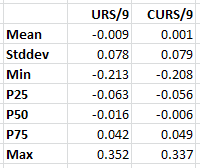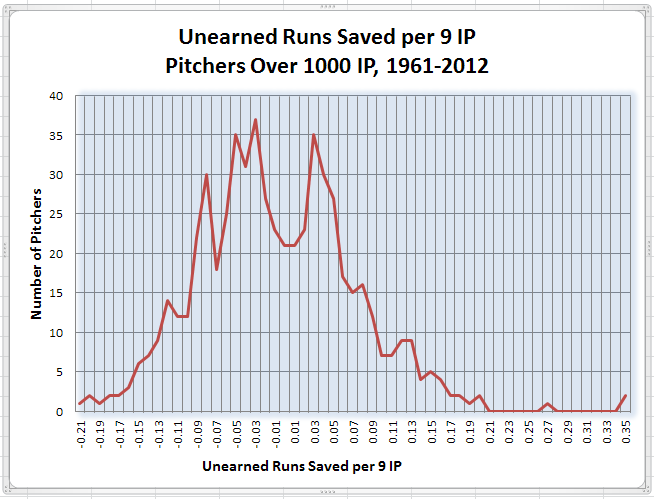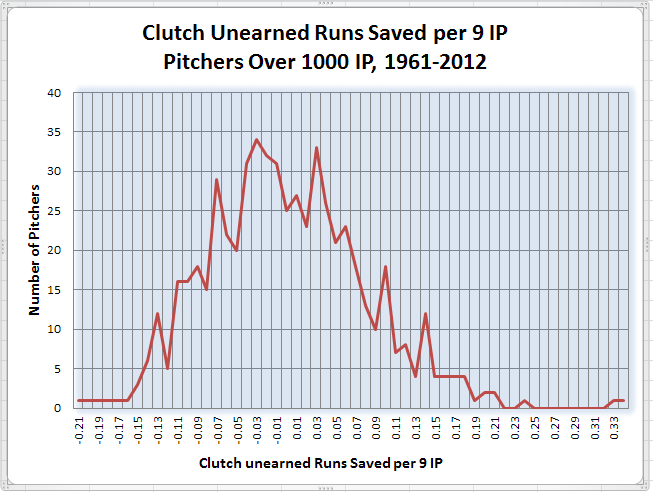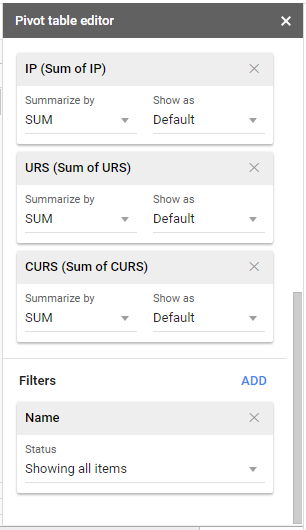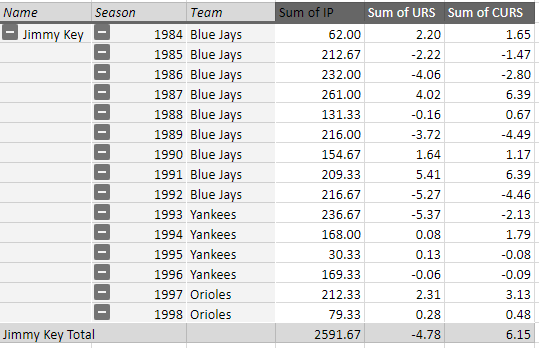When it comes to allowing unearned runs, are pitchers masters of their own fate, or innocent victims of circumstance (or, perhaps, not so innocent)? That is the question I’ll look at in this second installment on unearned run prevention.
In Part 1 of this series, I looked at what evidence there might be to support the hypothesis that unearned run avoidance was a skill that some pitchers could consistently demonstrate over their careers. The major conclusion was that, since 1961, team ERA and team unearned run prevention showed positive correlation. That is, of those teams successful in limiting unearned runs, the proportion with better pitching (i.e. lower ERAs) was higher than for groups of teams having less success in preventing unearned runs. This conclusion also seems intuitively correct – pitchers who are good at preventing earned runs are probably also good at preventing unearned runs.
In Part 2, I’ll take the next step and try to identify those pitchers who seem most and least adept at the skill of preventing unearned runs. Yes, I called it a skill because, while some errors lead immediately and unavoidably to runs scoring, many times the consequences are not so dire, affording pitchers the opportunity to work out of jambs caused by their defense. Whether because of temperament or determination, some pitchers seem to do this quite well, while others … well, not so much.
After the jump, more on pitchers and unearned runs.
Unearned Runs – a “treasure” to be shared
To properly evaluate a pitcher’s ability to prevent or limit unearned runs scoring, it would be appropriate to consider the “opportunities” that a pitcher has to practice this skill – a euphemism for how frequently a pitcher is victimized by his teammates’ (or his own) errors. Unfortunately, I haven’t been able to find these data. So, I will instead use estimation techniques to derive how many unearned runs individual pitchers on a given team would be expected to give up based on the team’s total unearned runs allowed. In Part 3, I’ll look at whether a team’s unearned runs seem low or high relative to the number of errors committed, and then see if those indicators correlate with the presence or absence of pitchers skilled in limiting unearned runs.
To quantify pitchers’ abilities in preventing unearned runs, I chose to view a team’s unearned runs as a pool of runs to be shared across the pitching staff. This premise is based on the notion that a team is always trying to play at its best, but that, unfortunately, errors still occur and can happen at any time. Thus, pitchers don’t cause the defense to commit errors, and the fact that some pitchers happen to have to deal with more errors than other pitchers on the same team is as much a matter of luck as anything else.
The premise in the preceding paragraph is fine as far as it goes. However, while pitchers may not cause errors, their pitching may influence the frequency of errors committed behind them. Pitchers who limit balls in play generally stand a better chance of having fewer errors committed behind them than do pitchers who have more “exciting” innings. The strikeout pitcher who is also stingy with hits and walks is probably ideally suited to limiting the errors his defense makes. In Part 3, I’ll more into what type of pitcher is best suited to limiting unearned runs. But for now, let’s get back to that concept of unearned runs as a team commodity to be shared among the pitchers.
Unearned Run Allocation
So, how should unearned runs be shared among pitchers? I tried two different methods that I’ll describe this way:
(1) Workload-based allocation
- a team’s unearned runs are shared among the team’s pitchers according to the proportion of the team’s innings that each pitcher worked
- pitchers who work more innings are allocated more unearned runs, and those working fewer innings are allocated fewer unearned runs
- pitchers with similar workloads are allocated similar numbers of unearned runs, regardless of the relative skill of such pitchers
(2) Skill-based allocation
- a team’s unearned runs are shared among the team’s pitchers according to the proportion of the team’s earned runs that each pitcher allowed
- good pitchers are “rewarded” with a lower allocation of unearned runs; bad pitchers are “penalized” with a higher allocation of unearned runs
Unearned Runs Saved
In both allocation methods, what is of interest is not the allocation itself, but the difference between the allocation and the actual unearned runs that a pitcher did allow, which I will call unearned runs saved or URS. Thus, a negative result is good, indicating a pitcher allowed fewer unearned runs than the portion of unearned runs allocated to him. Similarly, a positive result indicates a pitcher whose actual unearned runs allowed were more than the portion of the team’s unearned runs allocated to him.
So, what am I trying to measure here? The workload-based allocation is simply measuring the degree of deviation from a uniform world where all pitchers are equal and all will be equally affected by bad defense behind them. But, all pitchers are not equal, and the results from Part 1 of the study suggest that better pitchers should be more effective at preventing unearned runs. Therefore, the difference between actual and allocated unearned runs will measure how much better or worse pitchers are in unearned run prevention.
Responding to Misfortune
The second allocation is trying to measure something a bit more subtle. In a sense, it’s trying to get into the mind of the pitcher and gauge how he reacts to misfortune, specifically the misfortune of errors committed behind him. For example:
- One extreme is the pitcher who is upset with the mistakes of his teammates and loses his cool, affecting his performance in pitching to subsequent batters. Another variant of this extreme is the pitcher who feels sorry for himself and allows his concentration and effort to waver, secure in the self-fulfilling knowledge that “it just isn’t my day”.
- The other extreme is the pitcher who empathizes with the teammate who made the error, and wants to “pick him up” by exerting greater effort and determination to overcome the misfortune, and make even better pitches to subsequent hitters.
- In the middle are the professionals who just go about their business. Can’t do anything to change the past, so let’s get on with business and get the next out. The only pitch that matters is the next one. Insert your favorite hackneyed aphorism here.
So, you’re saying “Okay, I know what you’re talking about, but how the heck are you going to measure that?”. Well, as it turns out, the second skill-based allocation, while obviously not directly measuring subjective qualities, does provide some indication of which of those three types a given pitcher might be. That indication can then be “tested” according to anecdotal or even observational evidence for given pitchers
What the skill-based allocation will tell you is, when faced with adversity caused by his team’s defense, does a given pitcher perform better than he normally does, about the same, or worse? Thus, I’ve called this metric Clutch Unearned Runs Saved or CURS, indicating that overcoming the adversity of poor defense is indeed a form of “clutch” pitching.
You will recall that I said that, under skill-based allocation, a pitcher is rewarded by having a lower unearned run allocation. Except, I enclosed “rewarded” in quotations because it isn’t really a reward since what we’re looking at is the difference between actual unearned runs and allocated unearned runs. So, the smaller the allocation, the harder it will be to go even lower. But, that’s reality – if you’re a good pitcher, it’s tough to be even better. In practice, the pitchers who have the best opportunity to do well here are the inferior pitchers of the type 2 variety – with a big unearned run allocation, they have lots of room to improve.
Results
Most pitchers have a small number of unearned runs charged to them each year, though occasionally there can be quite a few more in a given season. The point is that you aren’t going to learn much from looking at a season’s worth of data – the likelihood is too high that what you’re seeing is just good or bad luck. However, over time, luck tends to balance out so that what remains provides an indication of a pitcher’s skill in preventing unearned runs. Thus, the data I’ll be showing you are for entire careers, or portions of careers, for the 589 pitchers with at least 1000 IP since 1961. All data have been extracted from the Fangraphs database.
Here are the moments for our URS and CURS metrics. I’ve converted URS and CURS into per 9 IP quantities, but the distribution is for unweighted values. Thus, all pitchers are equally weighted, regardless of innings pitched.
As you can see, there are very similar distributions for both the workload-based and skill-based allocation methods. Also, the mean for the subset of pitchers with 1000+ IP is almost bang on the true mean of zero for the entire population of all pitchers.
Below are charts visually depicting the two distributions.
The table below shows you all 589 of these pitchers. You can search for a pitcher by entering his name in the Search box, or sort by any of the listed fields. These are:
Unearned Runs Saved (URS) – these are the career totals since 1961 of the difference between a pitcher’s actual unearned runs and the unearned runs allocated to him via the workload-based allocation described above. Negative results are good, indicating a pitcher who allowed fewer unearned runs than those allocated to him.
Clutch Unearned Runs Saved (CURS) – this may not be the best name for this metric, but these are the career totals since 1961 of the difference between a pitcher’s actual unearned runs and the unearned runs allocated to him via the skill-based allocation described above. Negative results, again, are good, indicating a pitcher who allowed a lower proportion of his team’s unearned runs than of his team’s earned runs. A pitcher doing this consistently is probably pitching better in these “clutch” situations (i.e. after an error committed behind him) than he does overall.
As indicated above, pitchers who do well here tend to be of the inferior variety who have lots of room to improve whereas a good pitcher is probably doing well with a score near zero, indicating his normal level of solid performance is maintained in these clutch situations. Probably the most interesting result are the good pitchers who do poorly here – this may be an indicator of those pitchers who do not respond well to errors committed behind them.
URS/162 and CURS/162 – the same metrics as above, but shown per 162 IP as an approximation of runs saved (or not) over the course of a season
URS Rank, CURS Rank – ranking among these 589 pitchers for URS/162 and CURS/162.
[table id=98 /]
So, what are these numbers telling us? Because all of the URS totals are calculated for each player, season by season (and within a season, by team), you are seeing how well a pitcher did relative to other pitchers on the same team. So, comparing pitchers on different teams to each other is comparing how well each did in his own context. Which, when you come down to it, is what really matters. For example, in preventing unearned runs, this metric would show whether Andy Pettitte helped the Yankees more than Roy Halladay helped the Phillies, not whether or by how much either was better or worse than a major-league average pitcher, whatever that might be. It’s important to bear this type of comparison in mind when looking at scores for different pitchers.
Thus, the runs saved or not saved are indicative of how much a pitcher contributed to his team(s) over the course of his career. What these numbers are NOT telling you is how well a pitcher would have done had he played on another team. To compare pitchers to each other directly is probably most meaningful among pitchers who played a large portion of their careers on the same team, in front of the same defense. Thus, Smoltz, Glavine and Maddux could be a good group, or Koufax and Drysdale, Marichal and Gaylord Perry, etc.
Some observations on this measurement approach:
- Large URS numbers (20 or more, either positive or negative) are meaningful. Remember this is a zero sum method. All pitchers on a team sum to zero in every year. For a pitcher to compile numbers of that magnitude means they are consistently posting positive or negative scores in most seasons, something quite unlikely if this was all about luck. This is more especially true, still, if a pitcher played for different teams of varying quality through the course of his career.
- While the yearly run totals are, as explained, very context-sensitive, the summation of these run totals is not normalized. Thus, the win value of a run at different points in a player’s career is not factored into the career totals, nor are differences in win values of a run within a season owing to park effects. These would be useful enhancements to this approach.
- Remember that an average CURS score (i.e. near zero) is not bad. It just means the pitcher performed similarly with regard to allowing both earned or unearned runs. So, for example, Sandy Koufax was -24.3 URS, but only 1.2 CURS. That means he did very well (top 10%) in saving unearned runs, and allowed about equal shares of his teams’ earned and unearned runs (which, for a player with a 156 ERA+ during the years of this study, is very, very good indeed).
- URS does NOT love knuckleballers. Which kind of makes sense. Knuckleballs tend to result in more errors and more passed balls, both of which can lead to unearned runs. Thus, Phil Niekro, Tom Candiotti, Wilbur Wood, Charlie Hough and Tim Wakefield are all near the bottom in URS, in or very close to the lowest 10%. Tim Wakefield is dead last in URS among these 589 pitchers and his 64.3 URS total is 10 runs (okay, it’s 9.9) clear of number 588. I think you definitely want to look at RA more than ERA when evaluating a knuckleball pitcher.
The King of URS
So what about the guy at the top of our list? Not only did Curt Schilling rank first in career URS, he also ranked first in URS/162, despite pitching over 3000 innings, many more than the majority of pitchers in this study (number 2 in URS/162 is reliever Don McMahon, with just 1061 IP) . Thus, Schilling truly was consistent in compiling good URS scores just about every year (he had negative URS in 18 of 20 seasons), regardless of what team he was on. In addition, Schilling also ranked 13th of 589 in CURS, meaning he allowed a much smaller proportion of his teams’ unearned runs than of his teams’ earned runs – no mean feat considering Schilling’s career 127 ERA+. It would seem Schilling took errors as a challenge, determined not to let his opponents get “cheap” runs as a result. More conventional metrics also agree – Schilling has the lowest career % of runs allowed that are unearned (less than 5%) among all pitchers with 1200 IP since 1901.
Whether aptly named or not, since I had a metric called Clutch URS, I have to tell you about Jack Morris. Actually, Jack does pretty well with scores of -18.1 URS and -16.0 CURS, the result of posting consistent negative scores most of his career. Jack’s totals would have been considerably better (he was -30.3 URS and -22.6 CURS through the 1989 season) had he not posted some high positive scores in his final years.
For those with the inclination to dig deeper, this link will take you to a spreadsheet where you can select pitchers of interest and see their URS and CURS scores, on a season by season basis. To use the tool:
- Give Google a minute or two to load the data (there’s a lot)
- Click in the table to bring up the Report Editor on the right side, scroll to the bottom to the Filter box as shown below. Under Filter: Name will be shown the number of items (players) currently being displayed (should be just 1 for best results)
- Click on the little down arrow beside the number of items, and a selection pop up will appear
- Click on Clear to clear the current selection
- Enter the last name of the player of interest in the Search box, and select from the displayed search results
- Wait a moment or two, and the season by season results for that pitcher will be displayed (looks like below)
I’ll close with this listing of the 100 pitchers with the most innings pitched since 1961 (which just happens to be all pitchers over 2500 IP), sorted by URS.
Name IP URS CURS URS/162 CURS/162 URS Rk CURS Rk Combined Rk Curt Schilling 3261.00 -77.3 -50.1 -3.84 -2.49 1 13 14 Tom Seaver 4782.67 -63.2 -24.8 -2.14 -0.84 41 166 207 Don Sutton 5282.00 -61.1 -55.4 -1.87 -1.70 61 67 128 Bert Blyleven 4970.00 -60.9 -24.0 -1.98 -0.78 52 174 226 Roger Clemens 4916.67 -57.1 -1.0 -1.88 -0.03 60 305 365 Dennis Eckersley 3285.67 -55.1 -34.6 -2.72 -1.71 14 65 79 Luis Tiant 3486.33 -53.5 -37.9 -2.49 -1.76 22 60 82 Fergie Jenkins 4500.67 -52.6 -29.8 -1.89 -1.07 59 141 200 John Smoltz 3473.00 -48.5 -33.3 -2.26 -1.55 33 81 114 Bob Gibson 3722.00 -48.2 -18.1 -2.10 -0.79 46 172 218 Bret Saberhagen 2562.67 -44.9 -26.5 -2.84 -1.67 11 69 80 Pedro Martinez 2827.33 -43.1 -6.3 -2.47 -0.36 24 250 274 Javier Vazquez 2840.00 -36.6 -30.9 -2.09 -1.76 47 59 106 Doug Drabek 2535.00 -33.6 -28.6 -2.14 -1.83 39 50 89 Livan Hernandez 3189.00 -33.4 -37.9 -1.70 -1.92 73 44 117 Tom Glavine 4413.33 -31.0 -20.3 -1.14 -0.75 148 179 327 Catfish Hunter 3449.33 -30.9 -28.2 -1.45 -1.33 106 103 209 Jim Perry 2871.33 -30.7 -29.5 -1.73 -1.67 71 70 141 Vida Blue 3343.33 -29.4 -21.6 -1.42 -1.05 110 143 253 Rick Reuschel 3548.33 -28.1 -3.7 -1.28 -0.17 135 285 420 Dave McNally 2730.00 -27.5 -32.7 -1.63 -1.94 80 39 119 Mike Mussina 3562.67 -25.9 -6.8 -1.18 -0.31 143 259 402 Kevin Appier 2595.33 -25.6 -11.9 -1.60 -0.74 86 180 266 Dwight Gooden 2800.67 -25.0 -16.5 -1.44 -0.95 108 152 260 Bob Welch 3092.33 -24.5 -18.6 -1.28 -0.98 134 150 284 Doyle Alexander 3367.67 -24.0 -28.5 -1.15 -1.37 146 94 240 David Wells 3439.00 -23.9 -16.7 -1.12 -0.79 150 173 323 Andy Benes 2505.33 -23.6 -21.8 -1.53 -1.41 96 91 187 Steve Rogers 2837.67 -23.1 -6.7 -1.32 -0.39 127 241 368 Frank Tanana 4188.33 -22.9 -0.4 -0.89 -0.02 192 309 501 Jim Bunning 2667.33 -22.5 -9.8 -1.37 -0.59 122 206 328 John Candelaria 2525.67 -22.5 -11.9 -1.44 -0.77 109 175 284 Nolan Ryan 5386.00 -22.1 6.7 -0.67 0.20 230 338 568 Rick Sutcliffe 2697.67 -21.6 -20.0 -1.30 -1.20 132 124 256 Gaylord Perry 5350.33 -20.9 17.9 -0.63 0.54 235 391 626 Mickey Lolich 3638.33 -20.6 -13.3 -0.92 -0.59 181 207 388 Tim Hudson 2682.33 -19.0 -3.4 -1.14 -0.21 147 277 424 Mark Langston 2963.00 -18.2 -6.4 -0.99 -0.35 169 254 423 Jack Morris 3824.00 -18.1 -16.0 -0.77 -0.68 214 190 404 Dave Stewart 2629.67 -16.6 -18.9 -1.02 -1.16 163 127 290 David Cone 2898.67 -16.4 -2.8 -0.92 -0.15 182 287 469 Danny Darwin 3016.67 -15.7 -8.6 -0.84 -0.46 197 232 429 Stan Bahnsen 2529.00 -14.9 -20.3 -0.96 -1.30 175 106 281 Mel Stottlemyre 2661.33 -14.9 -4.2 -0.91 -0.26 186 266 452 Burt Hooton 2652.00 -14.7 -16.2 -0.90 -0.99 189 149 338 Mike Flanagan 2770.00 -14.2 -17.8 -0.83 -1.04 198 144 342 Dave Stieb 2895.33 -12.4 3.6 -0.70 0.20 227 339 566 Mike Moore 2831.67 -12.0 -16.5 -0.69 -0.94 229 153 382 CC Sabathia 2564.33 -11.8 6.5 -0.75 0.41 219 367 586 Milt Pappas 2626.67 -11.7 -9.5 -0.72 -0.59 223 210 433 Jim Palmer 3948.00 -10.9 7.4 -0.45 0.31 272 354 626 Claude Osteen 3400.33 -10.7 -7.8 -0.51 -0.37 258 247 505 John Burkett 2648.33 -9.4 -13.9 -0.58 -0.85 247 165 412 Jerry Koosman 3839.33 -9.0 -3.6 -0.38 -0.15 281 288 569 Bill Gullickson 2560.00 -8.9 -9.5 -0.56 -0.60 250 205 455 Rick Rhoden 2593.67 -7.7 -8.0 -0.48 -0.50 264 228 492 Frank Viola 2836.33 -6.9 4.6 -0.39 0.26 277 346 623 Mike Morgan 2772.33 -6.8 -9.8 -0.40 -0.57 276 211 487 Jamie Moyer 4074.00 -6.3 -1.2 -0.25 -0.05 299 302 601 Jimmy Key 2591.67 -4.8 6.1 -0.30 0.38 292 362 654 Roy Halladay 2687.33 -3.6 17.0 -0.22 1.02 306 460 766 Juan Marichal 3426.00 -2.8 29.9 -0.13 1.41 317 496 813 Steve Trachsel 2501.00 -1.0 0.4 -0.06 0.03 321 310 631 Scott Sanderson 2561.67 -0.3 -2.0 -0.02 -0.13 329 290 619 Kevin Millwood 2720.33 0.7 -0.8 0.04 -0.05 338 303 641 Fernando Valenzuela 2930.00 0.9 -3.4 0.05 -0.19 340 281 621 Jim Slaton 2683.67 1.4 -1.7 0.08 -0.10 341 295 636 Randy Johnson 4135.33 2.4 43.4 0.09 1.70 343 515 858 Jim Clancy 2517.33 4.2 -5.5 0.27 -0.35 362 253 615 Chuck Finley 3197.67 5.2 24.5 0.26 1.24 361 485 846 Bob Forsch 2794.67 6.9 2.5 0.40 0.14 379 330 709 Dennis Martinez 3999.67 8.0 7.8 0.32 0.32 372 356 728 Orel Hershiser 3130.33 9.0 18.2 0.47 0.94 393 450 843 Greg Maddux 5008.33 9.2 46.0 0.30 1.49 370 500 870 Bob Knepper 2708.00 10.1 4.4 0.60 0.27 417 347 764 Joe Coleman 2569.33 10.4 10.1 0.66 0.64 426 405 831 Steve Carlton 5217.33 10.8 37.7 0.33 1.17 373 475 848 Joe Niekro 3584.00 11.2 10.8 0.50 0.49 400 381 781 Mark Buehrle 2679.00 11.2 24.9 0.68 1.51 429 503 932 Mike Torrez 3044.00 11.3 -1.0 0.60 -0.06 415 301 716 Terry Mulholland 2576.00 11.9 6.6 0.75 0.42 440 368 808 Jeff Suppan 2542.67 11.9 7.4 0.76 0.47 442 377 819 Kenny Rogers 3302.67 12.6 28.4 0.62 1.39 420 494 914 Phil Niekro 5404.33 15.2 61.9 0.45 1.85 388 534 922 Tom Candiotti 2725.00 17.3 30.0 1.03 1.78 482 525 1007 Ken Holtzman 2867.33 17.9 15.8 1.01 0.89 480 445 925 Rick Wise 3127.00 18.8 21.3 0.97 1.11 476 464 940 Kevin Brown 3256.00 19.5 50.3 0.97 2.50 474 559 1033 Rudy May 2622.00 21.1 18.9 1.30 1.17 503 474 977 Derek Lowe 2658.33 22.2 24.0 1.35 1.46 510 498 1008 Wilbur Wood 2684.00 23.9 42.1 1.44 2.54 519 561 1080 Jerry Reuss 3670.00 25.0 20.4 1.10 0.90 489 446 935 Mike Cuellar 2804.00 25.3 31.2 1.46 1.80 522 531 1053 Charlie Hough 3801.00 25.4 31.0 1.08 1.32 487 491 978 Paul Splittorff 2554.67 26.4 22.9 1.68 1.45 535 497 1032 Andy Pettitte 3130.67 32.1 40.4 1.66 2.09 534 543 1077 Tommy John 4710.33 41.0 51.7 1.41 1.78 513 522 1035 Jim Kaat 4475.33 49.9 56.9 1.81 2.06 543 541 1084 Tim Wakefield 3226.33 64.3 61.7 3.23 3.10 586 577 1163

